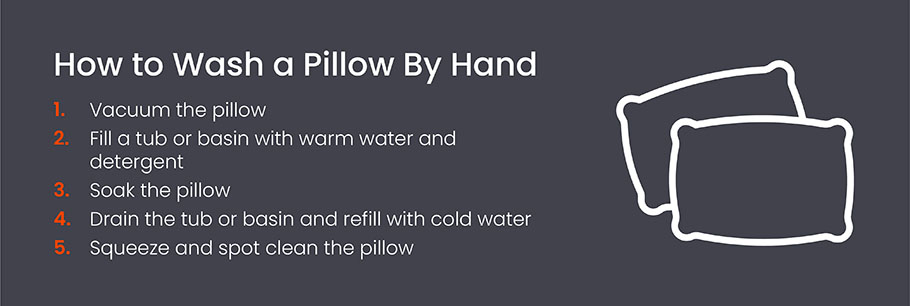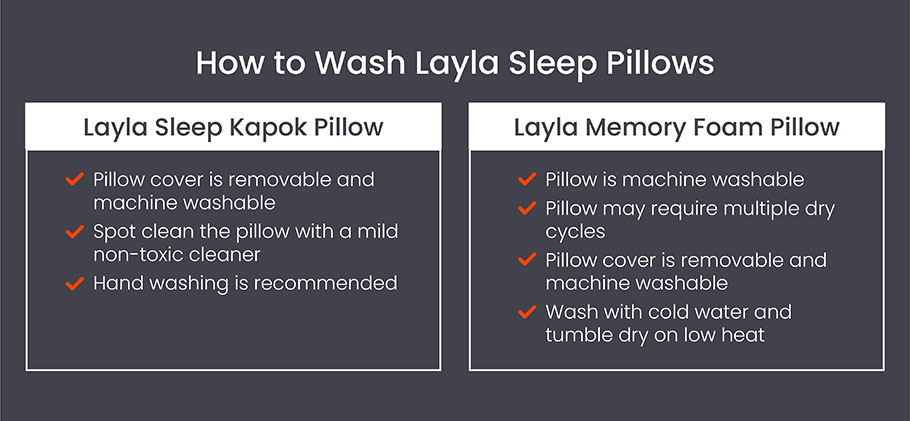How to Wash Pillows

You typically know when pillows start getting dirty. Since most pillows are white, you can start to see dust and stains from sweat as soon as they accumulate. As soon as your pillow starts looking or smelling dirty or musty, it’s time to wash it. This article will discuss everything you need to know about washing pillows, including when to wash them and how to do it.
- Why Should You Wash Your Pillows?
- How Often Should You Wash Your Pillows?
- Materials Needed to Wash Pillows
- How to Wash Pillows in a Washing Machine
- How to Wash a Pillow By Hand
- How to Wash Different Types of Pillows
- How to Dry a Pillow
- Final Notes
Why Should You Wash Your Pillows?
There are many reasons why you should wash your pillow. Not only can letting dirt accumulate on your pillow lead to worsening allergy symptoms, but it can affect your hair and skin while also affecting your ability to get the quality sleep you need. Here are the reasons why you should wash your pillow.
- Prevent acne: Pillows collect dirt and oil that you shed in your sleep. If you don’t clean your pillows, that dirt and oil can find their way right back to your skin and clog your pores, leading to acne. Washing your pillow regularly prevents your pillow from being the cause of a breakout.
- Remove odors: Dirty pillows are smelly pillows. By washing your pillow, you can remove any strange odors that have accumulated due to sweat and oil buildup.
- Reduce allergy symptoms: As we’ve mentioned, pillows collect dirt and dust, so if your pillow is unclean, it could have tons of dust on it that can contribute to an allergy flare-up just before it’s time for bed.
- Remove germs: Pillows are germy if they’re not washed and contain tons of bacteria.
- Prevent mold: If you drool or sweat in your sleep, you’re getting your pillow wet, and mold loves to grow in moist areas, so your pillow might need to be washed to prevent mold buildup over time.
- Improve sleep quality: Not washing your pillow can prevent you from getting the quality sleep you deserve for all the reasons listed above. For example, if your pillow causes you to have an allergy attack, you might not be able to get the quality sleep you need each night.
While pillowcases are designed to help protect your pillow from dust and dirt buildup, they can’t do everything. Remember, pillowcases are just extra fabric on top of your pillow, so drool and sweat can seep through them and into your pillow. Of course, you should wash your pillowcases about how often you should wash your sheets. However, your pillow also needs to be washed, just not as frequently as the cases.
How Often Should You Wash Your Pillows?
It’s typically best to wash your pillow every six months to help prevent dust and dirt buildup. You can wash your pillowcase when washing a weighted blanket or other throw blankets you might not need to wash as frequently as your bedding. How often you wash your pillow depends on several factors, but if you want to ensure your pillows are clean, you can wash them once every three months, especially if you’re prone to acne or you sweat or drool in your sleep.

Of course, washing your pillows is an important part of keeping your bed clean, but you should also know the importance of replacing pillows. Pillows that are too dirty to be completely cleaned or might be ruined in the wash should be replaced. Learning how to buy a pillow can help you determine which type of pillow is best for you based on your unique needs and sleeping position.
Materials Needed to Wash Pillows
Washing a pillow may seem like a chore. Luckily, many types of pillows are machine washable and can be washed on a gentle cycle with mild detergent. Unfortunately, some pillows will need to be hand-washed to ensure the materials don’t break down within the pillow and cause lumps and bumps. Here are the materials you need to wash a pillow:
- Washing machine
- Dryer
- Detergent
- Hot water
- Bathtub or basin
- Vacuum
- Bleach (optional)
How to Wash Pillows in a Washing Machine
As we’ve mentioned, most types of pillows are machine washable, so washing your pillows doesn’t have to feel like a chore. Here’s how to wash your pillows using a washing machine.

Read the pillow’s washing instructions
Not all pillows are machine-washable, so it’s best to consult your pillow’s instructions on the tag. If your pillow is washing machine safe, the instructions will also list out the proper way to wash them in a machine.
Add detergent
Most common detergents can be used on pillows, so you can use the same laundry detergent you use on your clothes on your pillow.
Use warm or hot water
Washing your pillow in hot water can help kill germs and bacteria. However, not all pillows should be washed in hot water as they could shrink. Again, always check your pillow’s care instructions on the label and use the right water temperature based on what your pillow says. Washing your pillow in cold water might not kill germs and bacteria, but it will prevent shrinking.
Wash on delicate
Washing machines are designed to be tough on stains and clothes. However, your regular wash cycle might be too much for a pillow. Instead, use the delicate cycle to ensure you won’t ruin the inner materials in your pillow, which can cause lumps and bumps.
How to Wash a Pillow By Hand
Some pillows can’t be washed in a washing machine and will need to be washed by hand. Washing your pillow by hand can ensure that the washing machine won’t accidentally shrink or destroy your pillow.

Vacuum the pillow
Before you use any water on your pillow, vacuum up any loose debris or dirt to make it easier to clean.
Fill a tub or basin with warm water and detergent
Luckily, you can wash your pillow in your bathtub as long as you’ve cleaned your bathtub of any dirt or mold first. Add mild detergent and warm water to kill bacteria lingering within your pillow.
Soak the pillow
Once you have your water ready, soak your pillow to ensure there isn’t a dry spot and that all of the inner material of the pillow is penetrated. You can lightly squeeze your pillow to remove any dirt.
Drain the tub or basin and refill with cold water
Drain the water and refill your tub with cold water to help remove the detergent.
Squeeze and spot clean the pillow
Once your pillow is submerged in cold water, you can start to spot clean the pillow and squeeze it to remove excess detergent.
How to Wash Layla Sleep Pillows
Layla offers the best pillows for sleeping, including the Layla Kapok and Memory Foam Pillow, which are not only comfortable but easy to take care of. The Layla Kapok Pillow comes with a removable, washable cover, and the pillow itself should be spot cleaned with a mild detergent. However, you can also put the pillow in the washing machine on the delicate cycle, but doing so could void the warranty if the pillow gets destroyed.
On the other hand, the Layla Memory Foam Pillow is designed to be machine washed. However, Layla makes it easy to ensure the cleanliness of your pillow by offering an inner lining, allowing you to remove the exterior pillow cover and wash that to reduce the risk of the pillow fill getting ruined in the washing machine or dryer.

How to Dry a Pillow
Washing a pillow is simple, but drying a pillow requires slightly more attention and maintenance. Incorrectly drying your pillow could ruin the fill and give you a pillow filled with uncomfortable lumps and bumps. However, not drying your pillow enough can make it susceptible to mold and mildew growth.
Always check the care instructions on your pillow tag before drying your pillow. Some pillows can be dried in a dryer on low or no heat. However, others should be air dried outside in the sun. Your pillows should be completely dried before you use them again.
Final Notes
Pillow maintenance is an important part of ensuring you get the quality sleep you deserve. While washing your pillows doesn’t have to occur as frequently as washing the rest of your sheets, you should still ensure your pillows are clean to prevent allergy flare-ups and keep you healthy and comfortable when you settle down at night.





